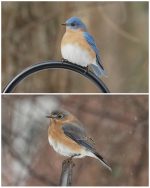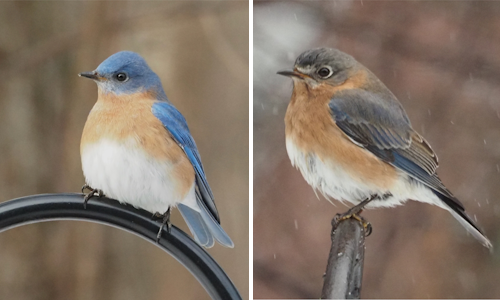Above: Learn more about Eastern Bluebirds and Bluebird Boxes in SOLF’s latest guest post. (photos contributed by Eileen Samberg)
[This post is part of a special guest series focused on appreciating nature in Southborough, contributed by the Southborough Open Land Foundation (SOLF), a non-profit dedicated to preserving and stewarding natural resources here in town.]
There is an old saying that the Bluebird is the bird “of happiness.” While this may be just a saying, seeing Eastern Bluebirds is undeniably a delight. Once uncommon in winter, an increasing number live in Massachusetts year round. They are usually found in fields near trees used for perching and nesting. The males can be identified by brilliant royal blue on their backs and heads, complemented by warm red-brown hues on their breasts, and the females by grayer backs and heads and subtle blue tinges in their wings and tails. They are typically not feeder birds, as their diet consists mostly of insects caught on the ground and occasionally seized mid-air, and berries when insects are not as plentiful. In the winter, they will occasionally seek nourishment at backyard feeders stocked with mealworms and shelled sunflower seeds.
Eastern Bluebirds nest in natural cavities like old woodpecker holes or specially designed nest boxes. The male attracts the female by carrying nesting material to the hole, going in and out, and waving his wings while perched above it. The female does the actual nest building. These captivating birds can have multiple broods in a season, starting in the spring and running through the summer.
 Bluebird boxes are a common sight in fields at nature preserves, strategically placed near but not too close to trees. Because the birds defend large feeding territories, a nesting box has to be at least 300 feet from any other box. A Bluebird box is constructed with a 1 ½ inch entrance hole and no perch, and is typically pole-mounted, at least 5 feet off the ground. Plans are underway to install some Bluebird boxes in the meadow at SOLF’s Beals Preserve for the Bluebirds that have been spotted there.
Bluebird boxes are a common sight in fields at nature preserves, strategically placed near but not too close to trees. Because the birds defend large feeding territories, a nesting box has to be at least 300 feet from any other box. A Bluebird box is constructed with a 1 ½ inch entrance hole and no perch, and is typically pole-mounted, at least 5 feet off the ground. Plans are underway to install some Bluebird boxes in the meadow at SOLF’s Beals Preserve for the Bluebirds that have been spotted there.
The boxes should be monitored once a week until hatchlings appear. Sparrows often try to nest in Bluebird boxes, so it’s important to remove their nesting materials to keep the boxes available for the Bluebirds. At the end of the season, the box should be cleaned out.
With a stroke of luck, you may get to see these beautiful Eastern Bluebirds of happiness in action.
Want to learn more about SOLF, or volunteer or donate? Check out our site, we’d love to hear from you.
Eileen Samberg, Trustee
SOLF – Southborough Open Land Foundation



Reader Bill Harrington shared a comment on this post that I’m passing along with his photo: